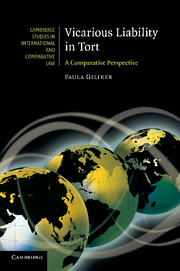Book contents
- Frontmatter
- Contents
- Diagrams
- Table of cases
- Table of legislation
- Preface
- 1 What is vicarious liability?
- 2 Establishing a general framework for liability
- 3 The employer/employee relationship: identifying the contract of employment
- 4 Special difficulties: borrowed employees and temporary workers
- 5 Other relationships giving rise to liability
- 6 Acting in the course of one's employment/functions/assigned tasks: determining the scope of vicarious liability
- 7 Parental liability for the torts of their children: a new form of vicarious liability?
- 8 Understanding vicarious liability: reconciling policy and principle
- 9 A postscript: a harmonised European law of vicarious liability?
- Appendix: Key provisions of the French and German Civil Codes
- Index
- Titles in the series
8 - Understanding vicarious liability: reconciling policy and principle
Published online by Cambridge University Press: 10 November 2010
- Frontmatter
- Contents
- Diagrams
- Table of cases
- Table of legislation
- Preface
- 1 What is vicarious liability?
- 2 Establishing a general framework for liability
- 3 The employer/employee relationship: identifying the contract of employment
- 4 Special difficulties: borrowed employees and temporary workers
- 5 Other relationships giving rise to liability
- 6 Acting in the course of one's employment/functions/assigned tasks: determining the scope of vicarious liability
- 7 Parental liability for the torts of their children: a new form of vicarious liability?
- 8 Understanding vicarious liability: reconciling policy and principle
- 9 A postscript: a harmonised European law of vicarious liability?
- Appendix: Key provisions of the French and German Civil Codes
- Index
- Titles in the series
Summary
Introduction
This book has examined the operation of vicarious liability across legal systems. As we have seen, one may identify a common general framework and three basic criteria: a particular relationship, the commission of a tort and some connection between the tort and the relationship in question. Beyond these key criteria a number of variables exist. Should the system be based on strict liability or fault? To what extent may an innocent party, forced to pay compensation to the innocent victim, be able to seek an indemnity from the tortfeasor? How broadly should the relationships giving rise to vicarious liability extend in the light of changing employment conditions? What connection is needed to trigger vicarious liability?
Previous chapters have sought to respond to these questions, analysing critically different legislative and judicial responses and assessing the ability of modern legal systems to establish a clear and socially-responsive doctrine of vicarious liability. This chapter has a different aim: to identify the key policy arguments which influence how legal systems apply the doctrine of vicarious liability. The nature of these arguments has altered with time, moving, as we will see, from a basis of fault to that of risk-based liability. The weight given to these rationales serves both to explain the legal responses of each system examined in this book, but also to enable us to critically assess the effectiveness of modern legal systems in responding to contemporary social and economic conditions.
- Type
- Chapter
- Information
- Vicarious Liability in TortA Comparative Perspective, pp. 227 - 254Publisher: Cambridge University PressPrint publication year: 2010



